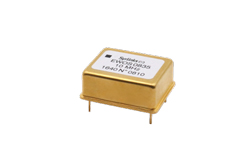
Field-programmable gate arrays (FPGA) are used in many RF applications for their parallel and fast digital data processing. In many such systems, a common frequency reference is used for the components doing the digital sampling (i.e., the analog-to-digital converters) and the FPGA processing (see Figure 1). For high performance RF designs, the question becomes the choice of the local oscillator (LO): Which type of LO to choose? Which frequency? The frequency stability, short and medium-term and the thermal sensitivity of the frequency? These questions are common and consistent for all radio system designs. Multiple technical demands constrain the LO, particularly for battery-powered systems where a precise power budget must also be met without sacrificing performance.
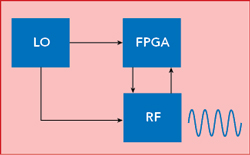
Figure 1 A common LO is often used for data conversion in the radio and data processing in the FPGA.
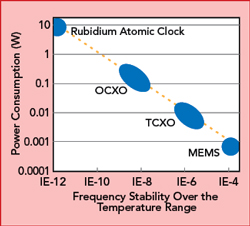
Figure 2 Typical power consumption vs. frequency stability for various oscillator types.
OSCILLATOR TECHNOLOGIES
Several oscillator technology choices are available, each with performance and price trade-offs (see Figure 2). Most consumer electronics products use basic oscillators costing just a few cents or euros, such as MEMS crystal oscillators or, in some cases, temperature compensated crystal oscillators (TCXO). For RF systems requiring high frequency stability and low temperature sensitivity, oven controlled crystal oscillators (OCXO) provide the highest frequency stability from among the various crystal oscillator technologies. They are typically 1000 to 10,000x more stable than an entry-level crystal oscillator.
OCXOs are complex, hybrid components that require significant know-how to develop. The frequency stability performance of an OCXO is driven by a simple physical principle: to maintain the quartz resonator at a precise temperature, regardless of the ambient temperature. Any quartz resonator’s frequency drifts strongly with temperature. For example, the frequency of a 10 MHz oscillator drifts ±250 to ±500 Hz between −40°C and +85°C. Maintaining the quartz at a precise temperature, an OCXO will reduce this drift to the range of ±0.05 to ±2.5 Hz, depending on the OCXO.
LOWERING OCXO POWER CONSUMPTION
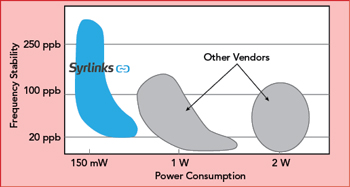
Figure 3 The EWOS OCXO family reduces power consumption while maintaining frequency stability.
Power consumption is the main disadvantage of OCXOs compared to TCXOs. To counter this, Syrlinks has developed a range of OCXOs with extremely low power consumption, mass and volume. These designs were optimized for the space radios developed by Syrlinks for small satellites, where little power is available. The EWOS™ OCXO family covers the frequencies between 10 and 40 MHz, with thermal sensitivities between ±5 to ±250 ppb and power consumption between 65 and 400 mW at 25°C. These power levels are extremely low, about 10x lower than competitive, commercial OCXOs (see Figure 3.
As well as being used in the space radios developed by Syrlinks, the EWOS OCXO products have been designed in other space applications, such as global navigation satellite system (GNSS) space receivers, where the combination of the FPGA and OCXO is ideal. For example, the EWOS0525 10 MHz OCXO is used in the GNSS receiver G-Sphere-S, where it is simultaneously clocking the RF digitization stage and the FPGAs. It demonstrated global position precision less than 10 m at high velocity (7700 m/s). This remarkable performance was achieved because of the very low phase noise of the OCXO, particularly close-in to the carrier frequency. For precise positioning or precise ranging functions, where position or distance are computed in less than a microsecond, OCXOs are always preferred. The performance and precision of positioning or distance measurements is directly linked to the short-term stability of the LO, making OCXOs preferred over TCXO. OCXOs provide better results for the designer.

Figure 4 EWOS OCXO family frequency stability vs. power consumption.
The EWOS83x family relies on SC-cut quartz resonators with a higher quality factor (Q-factor), which yields better phase noise and long-term frequency drift. Long-term drift is crucial for applications requiring precise time keeping when GNSS time is unavailable, such as underwater or other areas denied GNSS access. The quality of synchronization and time keeping depend exclusively on the intrinsic performance of the OCXO to keep accurate time. The EWOS083x provides aging of 0.3 ppb/day. The EWOS0835 is specified for underwater applications and has one of the lowest power consumption in the world: 80 mW at 25°C. For some applications, it is a low-cost alternative to chip-scale atomic clocks. Figure 4 shows the family of Syrlinks EWOS OCXO products.
NEW CLOCKS, TIMING MODULES
For the ultimate performance, Syrlinks innovates in the time-frequency domain with breakthrough MEMS-based miniature atomic clocks (MMAC™). Applying MEMS technology improves medium- and long-term stability by 100x compared to OCXOs, while keeping power consumption very low (< 200 mW at −40°C). For frequency synthesis applications between 8 and 50 GHz, Syrlinks is developing a new generation, 100 MHz OCXO adapted to embedded radio systems; this OCXO’s phase noise floor is −175 dBc/Hz.
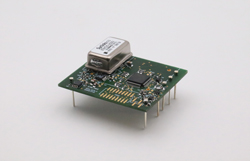
Figure 5 Syrlinks timing module with GNSS synchronization.
For designers looking for synchronization solutions, Syrlinks has developed a range of timing modules (see Figure 5) synchronized to a GNSS signal (e.g., Galileo, GPS) or an external reference (PPS_in). Embedded algorithms lock the phase and frequency of the OCXO, canceling drifts (i.e., thermal, aging, power supply, etc.). When GNSS time is not available (e.g., underwater), the SGTM keeps time and provides a precise PPS signal to the embedded system. The jitter between PPS_in and PPS_out is typically 12 ns, and the time holdover accuracy is ±35 μs per 24 hours, benefiting from advanced OCXO compensation.
An announcement exclusive to Microwave Journal: In the coming months Syrlinks will release a new 100 MHz OCXO for X- and S-Band low noise frequency synthesizers. This new EWOS will have extremely low phase noise close to the carrier (−130 dBc/Hz at 100 Hz offset), while keeping the power budget below 400 mW at 25°C.
Syrlinks
Cesson-Sévigné, France
www.syrlinks.com
